Asus Maximus VI Impact Review
Manufacturer: AsusUK price (as reviewed): £169.99 (inc VAT)
US price (as reviewed): $224.99 (ex TAX)
Every now and then we get to look at products that make our ears deaf to the cries coming from our wallets and are so swoon-worthy that they make every other product in their category, in this case mini-ITX motherboards, pale in comparison. This is certainly true of the first Asus Republic of Gamers mini-ITX motherboard - the Maximus VI Impact, which we heard rumours about early this year from a contact at the company.
At the time we weren't sure if Intel's LGA1150 socket would be the landing pad for this fascinating product but when we saw the first images prior to the launch of Z87-based motherboards earlier this year, our hopes were confirmed. Apart from the fantastic looks and ROG pedigree, the Maximus VI Impact proved one thing - mini-ITX motherboards are here to stay and the worlds biggest motherboard manufacturer had pledged its ongoing support for enthusiast-orientated products in the dinky board category following the successful P8Z77-i Deluxe.
Of course part of the compromise for bagging an ROG-branded product is usually a hefty price tag. Initial launch prices had the Maximus VI Impact retailing for closer to £200 but can now readily be found for less than £170. Even so, it's one of the most expensive mini-ITX motherboards we've ever seen and actually costs more than its micro-ATX sibling, the Maximus VI Gene, which sports extra PCI-E slots for sound cards and the like as well as supporting CrossFireX and SLI - usually the sticking point for those torn between a small or smaller system.
While the lack of PCI-E slots in addition to the main 16 x PCI-E 3.0 slot is a bitter pill to swallow for discrete sound card lovers, Asus has taken one giant leap towards appeasing you with what is essentially a discrete sound card attached at right angles to the main board PCB. This offers electronic shielding as a result, and the addition of TI LM4562 high-fidelity audio OP AMPs, 110dB SNR on the headphone DAC and 115dB SNR on the lineout jack mean that it's not likely to fall too far short of your average mid-range sound card and is hopefully going to be noticeably better than your bog standard Realtek embedded offerings.
Click to enlarge
USB ports are fairly well catered for, although there's only four at the rear panel backed up by another four USB 2.0, so this should should be ample for most scenarios. As per usual, there's a USB 3.0 header on the PCB adding a further two USB 3.0 ports but sadly no breakout bracket to use it is included in the box, although most mini-ITX cases cater for this nowadays with front panel connectors.
Click to enlarge
However, the price tag isn't totally unjustified. You get four SATA 6Gbps ports, all powered by the Intel Z87 chipset, as is an eSATA port on the rear I/O panel. These support RAID 0,1,5 or 10. New with some Z87 ROG boards is the mini PCI-E Combo II expansion card that supports M.2 SSDs, several of which are beginning to filter into retail channels from the likes of Intel and SanDisk. We do question how many enthusiasts would go this route, considering the extra cost, but at least the option's there.
Dual-band WiFi and Bluetooth bring up the rear on communication devices, but of course there's plenty more of note on the PCB. There are power and reset buttons, Probelt measurement points plus an LN2 mode jumper (mini-ITX extreme overclocking anyone?), and the rear panel has even more goodies such as a CMOS clear button, ROG connect switches and even an LED POST code readout. In short, the amount of features crammed into the PCB and indeed the rear I/O panel is staggering.
Click to enlarge
Despite this, the PCB is still impeccably laid-out with both the 8-pin EPS 12V connector and 24-pin ATX connector slap bang next to each other at the edge of the PCB as is the USB 3.0 header while most of the fan headers are too. The CPU socket area is obviously a little constrained at lower levels thanks to the VRM daughterboard and sound card PCB, however for most tower coolers and waterblocks there shouldn't be too many issues.
Speaking of waterblocks, for those of you considering dabbling with H20 and the Maximus VI Impact, Bitspower has a full-cover waterblock for it, similar to the one we reviewed for the Asus P8Z77-I Deluxe.
Specifications
- Chipset Intel Z87
- CPU support LGA1150 compatible
- Memory support 2 slots: max 32GB
- Sound ROG SupremeFX 8-Channel
- Networking Intel I217V Gigabit LAN, Dual-band WiFi 802. 11a/b/g/n/ac, Bluetooth 3.0+HS and 4.0
- Ports 4 x SATA 6Gbps via Intel Z87, 6 x USB 3.0 (2 x via header), 6 x USB 2.0 ( 2 x via header), 1 x LAN, audio out, line in, mic, Optical S/PDIF out, HDMI, DisplayPort, eSATA
- Dimensions (mm) 170 x 170 (mini-ITX)
- Extras WiFi Antennas, USB 3 breakout bracket

MSI MPG Velox 100R Chassis Review
October 14 2021 | 15:04


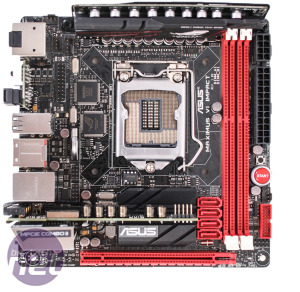
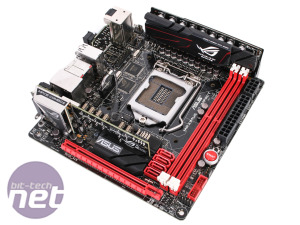
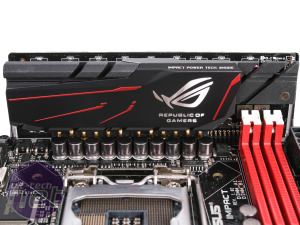
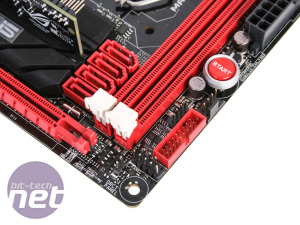
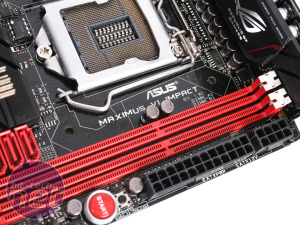

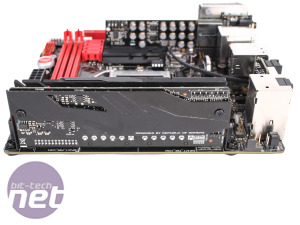
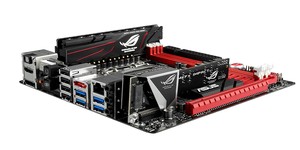






Want to comment? Please log in.